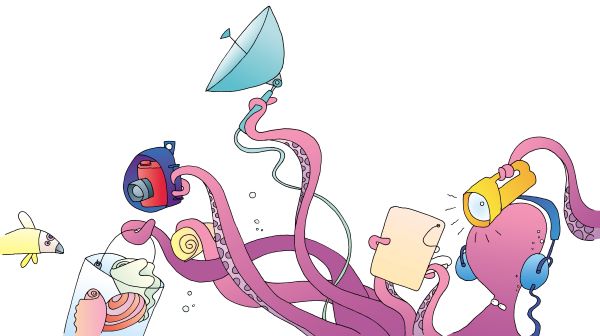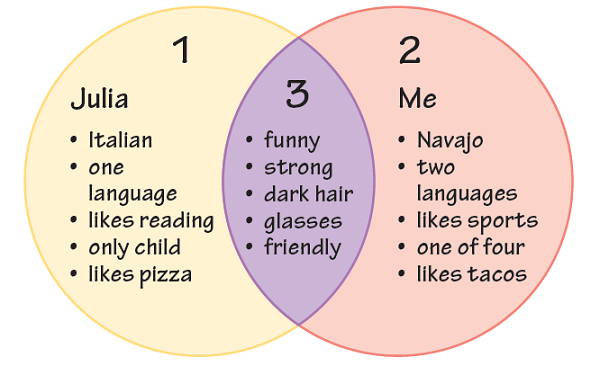Page 383
Using Graphic Organizers

Look at all the things Octavia Octopus is doing: gathering seashells, photographing fish, carrying a rolled-up map, listening for whale song. . . . How is she keeping track of it all?
Do you see her notepad? She’s drawing graphic organizers on it to store all the details she is gathering. Graphic organizers let you picture your thoughts and put them in order for use.
In this chapter, you’ll learn to use many types of graphic organizers. But try them one at a time. After all, you don’t have eight tentacles!
What’s Ahead
WE 384
Page 384
Kinds of Graphics

Graphic organizers come in many different shapes and sizes. On these two pages, you’ll find some common graphic organizers and tips on how and when to use them.
Web Organizer
Use a web organizer whenever you gather facts and details for reports, personal narratives, stories, and poems.
5 W’s Organizer
Use the 5 W’s to gather details for newspaper stories and personal narratives. (Download a 5W's chart.)
5 Senses Organizer
Use the 5 senses organizer to gather details for observation reports and descriptive paragraphs.
| Sight | Sound | Smell | Taste | Touch |
|
sunlight |
Canada geese |
freshly mown |
loaded hot |
smooth |
WE 385
Page 385
Compare/Contrast Organizers
The organizer shown below is called a Venn diagram. It can be used to organize your thoughts when you need to compare or contrast two subjects. Put the specific details for one of your subjects in area 1. Put the details for the second subject in area 2. In area 3, list the details the two things have in common. Then you can clearly see the similarities and differences. (Download a Venn diagram.)
Venn Diagram

Cause/Effect Organizers
You will use one of two different organizers when you record cause-and-effect details. It depends on your subject and how many causes and effects it has. Use these organizers when you gather details for explanations of science and history topics. (Download a cause-effect chart.)
Many causes, one effect
One cause, many effects
WE 386
Page 386
More Graphic Organizers
There are many other kinds of graphic organizers throughout your handbook. Check them out and think about how you could use each one to help you organize your thoughts.
Outline
An outline helps you organize information for book reviews, explanatory or persuasive essays, classroom reports, and so on. (See pages 49, 170, 200, and 259.)
Gathering Grid
Use this type of grid when you gather information from several sources. (See pages 44 and 257.) (Download a gathering grid.)
Reading Strategies
Consider using one of these two organizers to record details from your reading.
- Cluster Use it to think about details in a story. (See page 39.)
- Plot line Use it when you are reading about or planning the actions in a story. (See pages 241 and 317.)
Graphics
Diagrams, graphs, and tables are all helpful graphic organizers. Some diagrams work best for specific kinds of information:
- Cycle diagram Use this organizer when you read and write about science. (See page 333.)
- Picture diagram A picture diagram uses simple drawings. Use it to show how something is put together, how parts are related to one another, or how something works. (See page 333.)
Time Line
A time line shows the order in which things happened. Use it when you read or write about history. (See pages 50 and 177.) (Download a time line.)
Tips for Using Graphic Organizers
- Think about which organizer will work best for the kind of reading, writing, or thinking you are doing.
- Try several kinds of organizers. Seeing information in two or three different ways can help you learn and remember better.
- Invent your own graphic organizer! You may think of a whole new way to visualize your thoughts.